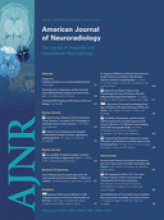Abstract
BACKGROUND AND PURPOSE: Both the existence and clinical relevance of a steal phenomenon in brain arteriovenous malformations (AVMs) remains a matter of debate. This study aimed to assess perfusion in the brain adjacent to brain AVMs and to relate these to macrovascular blood flow in a single measurement.
MATERIALS AND METHODS: Twenty consecutive patients with AVMs with a median age of 37 years were evaluated by 3T MR imaging by using 3D time-resolved MR angiography to determine blood flow and perfusion patterns. Cerebral perfusion was estimated by using an arterial spin-labeling technique in vascular territories around the nidus and in symmetric regions of interest in the ipsilateral and contralateral hemispheres. Mapping of concentric shells around the nidus was used to define the immediate and adjacent brain and relative perfusion reductions >20% of baseline, termed perinidal dip (PND).
RESULTS: A significant reduction in perfusion ratios between ipsilateral and contralateral hemispheres remote to the AVMs was demonstrated in the middle and posterior cerebral artery territories. PND was detected in 5 patients, and 17 patients overall showed reduced perfusion in the perinidal region on visual inspection. There was a negative correlation of the hemispheric territorial perfusion with the affected/nonaffected inflow time ratio (R = −0.402, P = .015).
CONCLUSIONS: The perfusion impairment in vascular territories adjacent to brain AVMs that we identified as PND may reflect the existence of 2 levels of perfusion impairment: a territorial and a microvascular perfusion disturbance. Although the hemispheric asymmetry in territorial perfusion seems the result of arterioarterial redistribution, the PND was inhomogeneously distributed within a single vascular territory and thus might result from low perfusion pressure in small arteries and arterioles.
- Copyright © American Society of Neuroradiology











